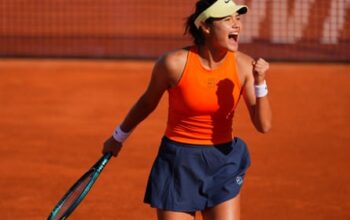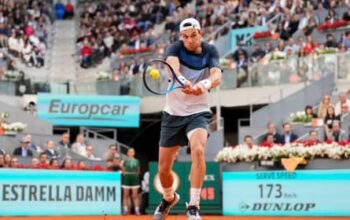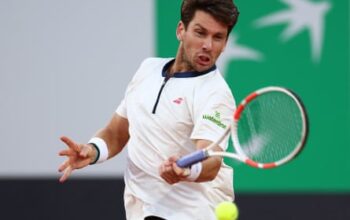Jannik Sinner, the men’s world No 1 tennis player, has avoided a doping ban after he successfully argued that two failed anti-doping tests in March had been a result of contamination through his physiotherapist.
Following an independent tribunal last week, a panel ruled that Sinner bore “no fault or negligence” for twice testing positive for trace amounts of the banned substance clostebol. Clostebol is an anabolic androgenic steroid (AAS) derived from testosterone and the concentrations of 121 picograms per millilitre (pg/ml) and 122pg/ml in Sinner’s two positive tests amount to less than a billionth of a gram. With over-the-counter drugs in Italy containing clostebol, numerous Italian athletes have tested positive for the substance in recent years.
“I will now put this challenging and deeply unfortunate period behind me,” Sinner wrote in a statement. “I will continue to do everything I can to ensure I continue to comply with the ITIA’s anti-doping programme and I have a team around me that are meticulous in their own compliance.”
After Sinner’s positive test, the International Tennis Integrity Agency (ITIA), which handles anti-doping and corruption in tennis, consulted with scientific experts and then took the case to the independent tribunal, which was held last week on 15 August.
Sinner’s arguments hinged on his fitness trainer Umberto Ferrara’s purchase of Trofodermin, an over-the-counter spray used to heal cuts. While Sinner and his team were staying at a villa in Indian Wells ahead of the Masters 1000 event, Giacomo Naldi, Sinner’s physiotherapist, accidentally cut his finger on 3 March with a scalpel.
After the bandage was removed, Naldi used Ferrara’s Trofodermin each morning on the cut between 5 and 13 March. During that period, Naldi continued to treat Sinner with full body massages and he bandaged Sinner’s feet.
Sinner suffers from a skin condition called psoriasiform dermatitis on his feet and back, which causes itchy skin and the 23-year-old’s scratching can lead to small cuts and sores. Sinner and his team argued that he had been contaminated through the treatment he received from Naldi, who did not use gloves. Three scientific experts confirmed that this was a plausible explanation for the presence of clostebol metabolites.
Crucially, Sinner maintains that he did not know about either Ferrara’s possession of Trofodermin or the fact that Naldi was using it. The ITIA accepted Sinner’s arguments on the balance of probability and the subsequent independent tribunal concluded that the player had “no reason” to suspect the presence of Trofodermin around him or any anti-doping risk from his treatment with Naldi.
Karen Moorhouse, the ITIA’s chief executive, said: “Following that investigation, the ITIA accepted the player’s explanation as to the source of the clostebol and that the presence of the substance was not intentional. This was also accepted by the tribunal. We thank the independent tribunal for the speed and clarity of its decision in relation to the player’s degree of fault.”
The ATP wrote in a statement: “We are encouraged that no fault or negligence has been found on Jannik Sinner’s part. We would also like to acknowledge the robustness of the investigation process and independent evaluation of the facts under the Tennis Anti-Doping Programme (TADP), which has allowed him to continue competing. This has been a challenging matter for Jannik and his team, and underscores the need for players and their entourages to take utmost care in the use of products or treatments. Integrity is paramount in our sport.”

Neither of Sinner’s positive anti-doping tests had previously been made public. The first positive test took place in-competition on 10 March during Indian Wells and trace amounts of a metabolite of clostebol were also found in an out-of-competition test on 18 March, just before the Miami Open, which Sinner won. His semi-final result at Indian Wells has been disqualified along with 400 points and the $325,000 (£250,000) prize money earned.
While athletes receive automatic mandatory provisional suspensions after being notified of an anti-doping rule violation, it can be appealed and removed if an athlete demonstrates at a hearing that the violation likely involved a contaminated product or a substance of abuse.
Sinner was provisionally suspended from 4 April until 5 April, shortly after winning the Miami Open, and then just before the Madrid Open between 17 April until 20 April. Both times, the provisional suspension was cut short after Sinner successfully appealed them. In a busy period of the ATP calendar during the clay-court season, both short-lived provisional suspensions occurred during off-weeks.
Some of Sinner’s fellow players have been critical of the findings: “Can’t imagine what every other player that got banned for contaminated substances is feeling right now,” wrote Denis Shapovalov.
Sinner has continued to compete on the ATP Tour as normal in what has been a breakout season, with the Italian winning his first grand slam title at the Australian Open and rising to No 1 shortly after. On Monday Sinner won his second Masters 1000 title at the Cincinnati Open and he boasts a tour-leading 48-5 record this year.


